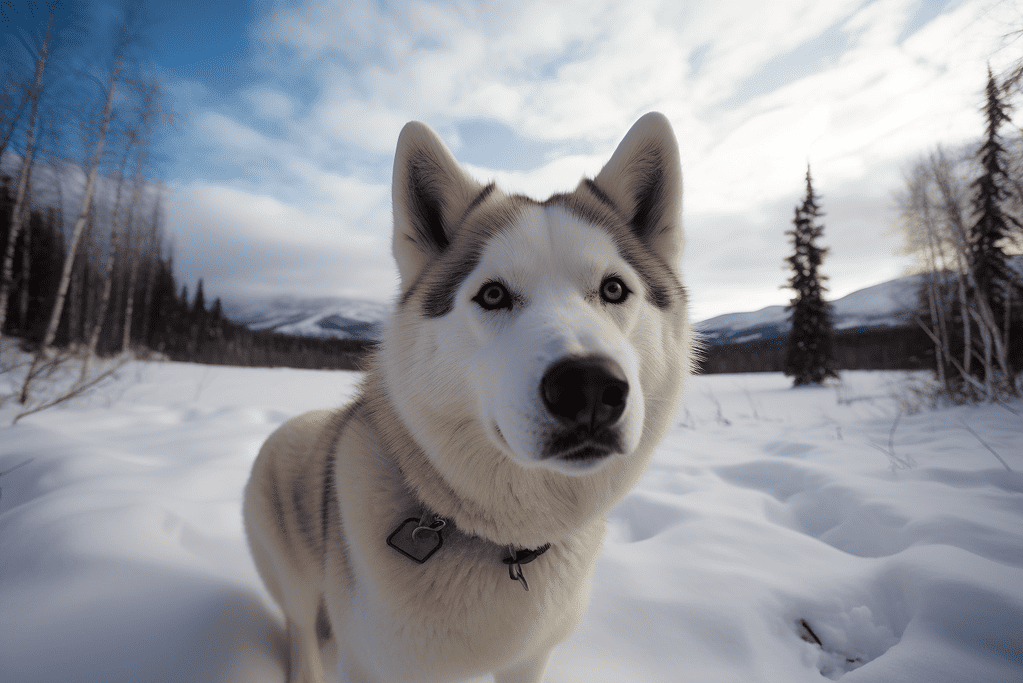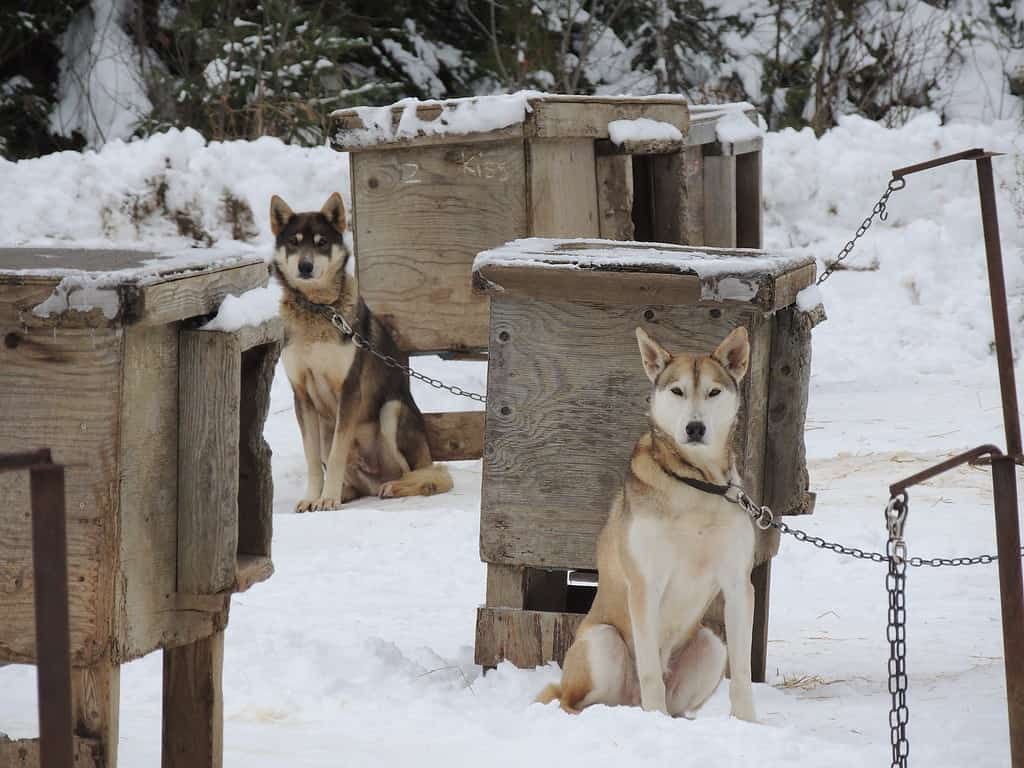
Alaskan Husky Canine Breed: Details, Images, Care Tips, Trivia & Beyond!
Shortcuts
The Alaskan Husky is a lesser-known relative of the Siberian Husky. These remarkable dogs are bred for their work ethic and disposition, rather than their appearance. Since they aren’t registered as an official breed like their Malamute and Siberian counterparts, you’ll find them in a delightful variety of sizes and colors. As a breed built for labor, Alaskan Huskies are energetic and task-oriented. If you’re considering adopting this versatile sled-dog, be prepared to have energy of your own!
Breed Overview

Height
23-26 inches
Weight
40-60 pounds
Lifespan
10-14 years
Colors
Black, Grey, White, Red, Brown, Sable, Agouti
Suitable for
Active individuals and families looking for a friendly and energetic companion
Temperament
Friendly, sociable, energetic, intelligent, hardworking


Height
23-26 inches
Weight
40-60 pounds
Lifespan
10-14 years
Colors
Black, Grey, White, Red, Brown, Sable, Agouti
Suitable for
Active individuals and families looking for a friendly and energetic companion
Temperament
Friendly, sociable, energetic, intelligent, hardworking

The Alaskan Husky, a strong and athletic breed, is renowned for its role in sled racing. With roots in the cold North, it embodies endurance and teamwork. Its adaptable nature and connection to the wild continue to captivate those drawn to adventure and the great outdoors.
Characteristics
Energy

Health

Sociability

Trainability

Lifespan


Enjoying this read?
We publish this content for free to generate interest in our Premium members' area. By subscribing, you can ask the writer any questions related to pet care and this article, get access to 100+ Premium Pet Care Guides and go Ad-Free with DogFix Premium for $2.99.
Health Conditions
As a dedicated sled dog, the Alaskan Husky is meticulously bred for optimal health and stamina. However, despite these efforts, they can still be prone to certain health issues. It’s important for potential owners to be financially prepared for any future medical expenses that may arise.
Minor Conditions
- Skin Allergies
- Eye Infections
- Ear Infections
- Dental Issues
- Minor Injuries
Serious Conditions
- Hip Dysplasia
- Gastric Dilatation-Volvulus (GDV) or Bloat
- Hypothyroidism
- Progressive Retinal Atrophy (PRA)
- Cancer



Choosing an Alaskan Husky Puppy: What to Keep in Mind
Alaskan Huskies, being working dogs rather than a specific breed, are relatively rare, leading to fluctuating prices based on genetics and work potential. Finding a reputable breeder for these designer-like dogs, selected for particular traits, can be challenging due to the prevalence of inexperienced “breeders” in the market. Take care to check the validity of your breeder.

The Personality and Intellectual Capacity of Alaskan Huskies
A typical Alaskan Husky, possessing the attributes mentioned above, will be an active, focused canine that is also playful, gentle around children, and affectionate with their handlers. These dogs may not be the best choice for first-time owners, as interpreting their behavior can be challenging and may be mistaken for disobedience or stubbornness. However, for those experienced with working breeds, and who have time to devote to these dogs, affection and love will follow. These are dogs who bond terrifically with a loving owner.
The primary challenge many Husky owners face is time – there often aren’t enough hours in the day to devote to these energetic dogs. Alaskan Huskies thrive on having a job to do and should not be left alone for extended periods, lest they become bored and wreak havoc on your home.
They are also prone to separation anxiety resulting from a lack of exercise or human interaction, as they are accustomed to spending significant time with their sled leaders. This is an essential aspect of their selective breeding to bear in mind when considering an Alaskan Husky as a potential pet.

Evaluating the Suitability of Alaskan Huskies for Family Life
Alaskan Huskies, like many other working breeds, require more than just a few walks and play sessions to keep them content. Their energetic minds need constant stimulation, making it essential to tire them out daily for a harmonious household. Due to the challenges they can pose for inexperienced dog owners, Alaskan Huskies may not be the best option for families getting their first dog.
However, if you’re prepared to devote ample time to outdoor play and long-distance hiking, an Alaskan Husky could be a wonderful, affectionate addition to your family. These dogs are generally gentle and playful around children, but it’s crucial to supervise their interactions for everyone’s safety. If your family has several hours a day to dedicate to a working dog and enjoys activities like camping and long hikes, an Alaskan Husky may be the perfect companion for your adventurous lifestyle.

Assessing the Compatibility of Alaskan Huskies with Other Pets
Alaskan Huskies are not limited to being sled dogs; they are also known for their ability to thrive within a pack’s social structure. These dogs not only get along well with their canine counterparts but can form strong bonds, even if the other dog is merely a pet or companion. Ideally, Alaskan Huskies should be raised alongside other dogs, but they will also readily adapt to the presence of existing dogs in a household. While their bonding with other dogs is exceptional, it is essential to note that these Huskies possess a relatively strong prey drive, which can lead to chasing behavior.
With patient training and gradual introductions, they can coexist peacefully with cats. Some may even form a bond with their feline housemates, although this is less common. It is important to remember that achieving harmony between an Alaskan Husky and a cat may take time and may not always be successful due to their innate predatory instincts.
Similar issues may arise with smaller animals such as birds, rodents, and rabbits. Any introductions should be closely monitored, as the success of these relationships will depend on the individual reactions of both animals. While some Alaskan Huskies may live harmoniously with birds, others may remain determined to catch them. Reptiles and lizards, on the other hand, may pique a Husky’s curiosity more than trigger their hunting instincts. However, caution should still be exercised, as chasing and hunting behaviors can still occur.

Nutritional Needs and Feeding Guidelines for Alaskan Huskies
As a breed known for their strength and endurance, Alaskan Huskies require a well-balanced diet to maintain their impressive abilities, whether they’re pulling sleds or not. The ideal diet varies a little depending on the nature of the dog’s daily activities, but definitely ensure your Husky does not become too heavy. For optimal results, it can be recommended to seek the advice of a veterinarian to determine the most suitable food and portion sizes for your Husky.

Exercise Guidelines for Maintaining a Healthy Alaskan Husky
Originating from a lineage of sled dogs, Alaskan Huskies possess remarkable stamina and endurance. A mere stroll around the block won’t satisfy their need for physical activity, so it’s crucial for potential owners to recognize their daily exercise requirements. If you’re considering adding an Alaskan Husky to your family, be prepared for frequent hikes or even participating in canine sports.
Many Husky enthusiasts engage in activities such as ATV dog sledding or bikejoring (bike-pulling) to allow their furry companions to embrace their natural pulling instincts. In essence, Alaskan Huskies thrive when they have ample opportunities for work or exercise each day.

Key Training Tips for Alaskan Huskies
Training Alaskan Huskies may be comparatively easier than Siberian Huskies, given their breeding purpose leans towards work. Nevertheless, their inherent intelligence and independence require ample patience when training them. Engaging them in physical exercise not only dissipates their energy but also helps to make training sessions less disorderly.
Once Alaskan Huskies learn a command, they’re likely to remember it throughout their lives. Consistency and confidence in your approach will enable your Alaskan Husky to grasp things quickly. For first-time sled dog owners, seeking the help of a professional dog trainer is highly advised.

Grooming Essentials for Alaskan Huskies
Alaskan Husky fur is dense and plush, featuring a double-layered coat designed to withstand the extreme cold and snowstorms experienced during sledding. To help manage shedding, it’s advisable to brush their coats once a week, especially during their “shedding seasons” when hair loss significantly increases. Although brushing can alleviate some shedding, it’s crucial not to shave your husky unless it’s absolutely essential, as their coat may not regrow as it once was.


Comparing Male and Female Alaskan Huskies
Male Alaskan Huskies tend to be significantly larger than their female counterparts, often weighing over 20 pounds more. If size is a concern for you, a female husky might be the better choice. Ultimately, the decision comes down to personal preference and should involve input from all family members.

An Intriguing Tidbit About the Alaskan Husky
Interestingly, the Alaskan Husky is not an officially recognized breed. These hardworking sled dogs have been selectively bred for their performance abilities rather than conforming to a specific purebred standard. As a result, they display a wide range of appearances and are not acknowledged by major kennel clubs, making them more of a canine category than a distinct breed.

Another Fascinating Fact About the Alaskan Husky
Although Siberian Huskies are well-known sled dogs, Alaskan Huskies are actually larger and more robust in build, resembling Alaskan Malamutes. This makes them even more dependable for sled-pulling activities than their Siberian counterparts.

One More Insight into the World of Alaskan Huskies
Despite their independent streak, these dogs form strong bonds with their handlers, showering them with affection. However, their playful mischief makes them better suited for seasoned handlers.

Summing Up the Alaskan Husky
The Alaskan Husky is a purpose-bred canine, meticulously crafted to embody the ultimate sledding companion. Although not officially recognized as a breed, these diligent dogs are specifically bred to excel in their working roles. Outperforming Siberian Huskies in sledding tasks without the bulky stature of Alaskan Malamutes, these hybrid workers thrive in an active lifestyle. They can make fantastic pets for devoted owners who can dedicate ample time for daily exercise and maintain a consistent routine.


Didn’t find what you need? Use the search!
Search our database of over hundreds of posts with up-to-date information from our experts and veterinarians.

